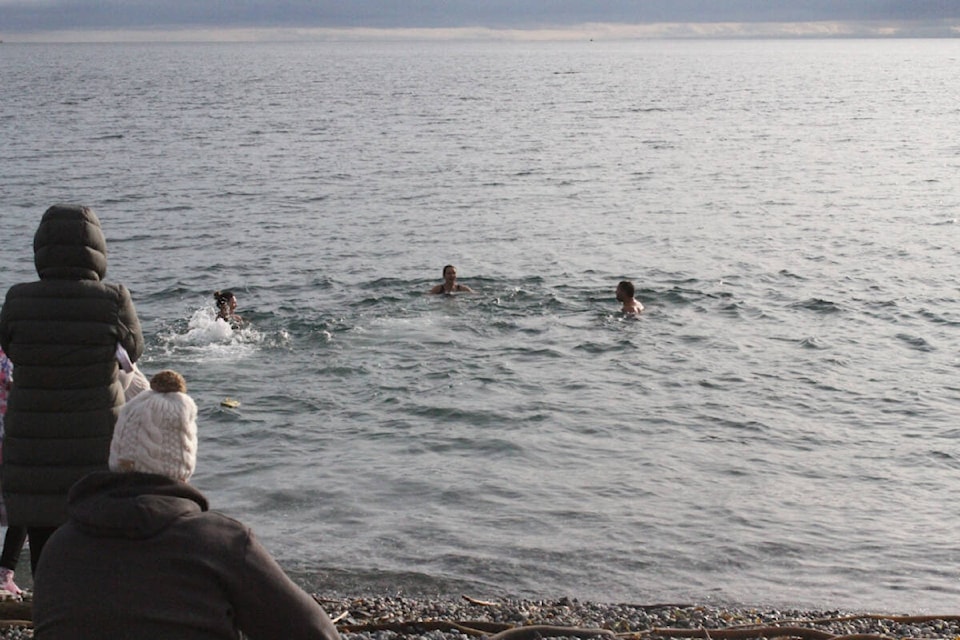Polar bear plunges can be hard on people who do it, yet can have health benefits, says biology professor Patrick Walter.
Polar plunges or ice baths are when people swim in cold water around to try and boost tolerance to extreme conditions.
A lot of people who participate will witness an extreme temperature change for the 90 seconds they are in the water, explained Walter, an adjunct professor in the biology department at the University of Victoria.
“They start breathing very rapidly, and that’s usually staying in the water for 90 seconds to a minute, and they’re out again. And all they’re doing in that period is experiencing a sharp, mostly sympathetic response.”
A sympathetic response is a flight or fight response, where your body responds to your central nervous system and increases the level of epinephrine and cortisol in your body, he said.
While extreme cold conditions can be dangerous for people who suffer from cardiovascular diseases, Type 2 diabetes or are pregnant, they can cause a huge increase in the feel-good brain chemical dopamine, he said.
There are benefits of polar plunges, cold showers or ice baths, but it would require someone to become more acclimated to the cold with regular swims or ice baths.
“If you do this on a weekly or daily or some somewhat of a scheduled basis, your body will start to make changes in response to that temperature change.”
Breathing becomes incredibly important at extreme temperatures, and with frigid temperatures, you want slow rhythmic breathing so you do not blow off any heat your body produces, he said.
“To adapt to a cold environment, you have to do these really slow, deep diaphragmatic breathing exercises to keep your body in a warmer state.”
Walter said it is essential to keep safe and that going with a group is as important as having the right equipment to go in the water safely and return, especially on days like Jan. 12 when the temperatures around Greater Victoria plummeted to -20 C.
“You should never stay in the water longer than what becomes uncomfortable for you,” he said. “If you stay long and you get sore fingers or toes, and most people jump in the hot shower, it hurts because all the blood is rushing back in after it’s been constricted. You can make it a pain, and it doesn’t have to be painful.”
The benefits of cold plunges or polar bear swims can be increased brown fats and decreased inflammation. According to Walter, there will be an increase in dopamine levels and an improvement in how the body handles blood sugars.
Brown fat helps to break down blood sugar and fat molecules to create heat and maintain body temperature. Cold temperatures help activate this fat, leading to various metabolic changes in the body.
This fat differs from the more common white fat, which stores excess energy and can lead to health conditions such as obesity.
He said evolution has played a big part in how humans can withstand such cold temperatures and gain some benefits for the body.
“I think that the people we evolved from for many thousands of years, they were without any fire and certainly wouldn’t have had a portable fire.”
Our ancestors, he said, certainly would not have had access to all the high-tech gear we have available today, and even simple items of clothing like toques and gloves would have been a foreign concept to our ancient relatives.
Walter became interested in the impacts of extreme temperature on the body while conducting clinical research at the University of California in San Francisco.
“Diseases like thalassemia, sickle cell anemia and different types of anemia that cause iron overload. It’s a paradox. I was very interested in ventilation, breathing and health.”
Walter will take a group of people with him for his icy swims, but he said his group will do various activities. Some of them will exercise out of the water to get acclimated to the cold air, a dip where they will stand, then get out, and then a longer swim where they will spend 10 to 15 minutes in the water.
“The swimming we do is easier than on Fridays when we go into the water and talk to each other. We don’t do any exercise at all. That’s harder to do than to swim. You’re burning a tremendous amount of calories, and your muscles produce a lot of heat. So you can tolerate more cold exposure when working in the cold. “
Cold exposure or cold immersion has been used to treat various mental health conditions in the United Kingdom, but Walter said this is still on the fringes and that the practice has not made its way to Canada just yet.
He said that drugs such as selective serotonin reuptake inhibitors, which are given to people who suffer from severe mental health conditions as a way to help regulate serotonin levels in the body, are overprescribed these days
“There’s certainly a population that needs to be treated. I’m empathetic to that. But the fact is that you’re not treating them with things like yoga, breathing, meditation, or cold exposure.”



